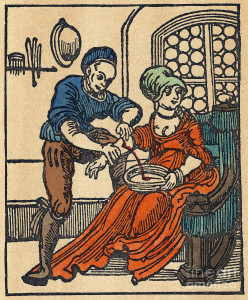
I came across an interesting article on bloodletting trying to explain its success and wondered if there might be alternative factors:
- the availability effect
- the recency effect
- the post hoc ergo propter hoc-fallacy
- incentives
- activity vs. passivity (sense of agency)
- the placebo effect
1. Availability – Frequency:
If one asks in which instances do we see blood, it seems there are a quite few occasions. Maybe even more so in the past than in the present. (Assumption: I don’t have historical data on the prevalence of bleeding as percentage in occurence in illnesses. I assume one might be able to find it).
Bleeding is quite common (in women even more so), observable and often non-lethal. People get better. (Edit: The same with f.e. the common flu, after a lot of sneezing, coughing up phlegm and blowing one’s nose (relieving oneself of unwanted substances in more or less liquid form)) Inversely, death itself and many illnesses do not involve any bleeding…
2 and 3. Recency and Post hoc, ergo propter hoc:
Especially in common cases of inflammation by an object/sting etc., the cure often seems to open the wound and push the puss/splinter etc. out. The marker that seems to say: “you’re good” is, apart from relieved pressure etc., no more puss comes out of the wound, instead of it we push blood out of it. If the inflammation is not contained by the immune reaction of the body, it can lead to a lethal sepsis (blood poisoning). (Edit: I wonder if this was sometimes called “bad blood”?)
So if we now assume, that this “blood comes out of the body” was the last thing which happened, is interpreted as a sign for “you’re going to be ok”, then this fits well into Hugo Mercier’s et al. attractor/reasoning/relevance argument. It also fits well with availability bias, recency bias and post hoc, ergo propter hoc fallacy.
The symptom becomes a cause, since we just seem to know from experience that after blood letting the person gets better (pattern recognition = then and then and then), but we don’t have a better model to explain the phenomenon for it (theory of mind). To a man with a hammer, everything looks like a nail.
4, 5 and 6. Incentives, activity and placebo:
If a little bloodletting would normally not kill a patient, it was a rather safe way of generating revenue. The equivalent of that today might be the prescription of some drugs or treatments.
It also seems that many common diseases in the past were not very well treatable: Dysentery (the “bloody flux”), Ergotism (“St. Anthony’s fire,” “holy fire,” “evil fire,” “devil’s fire,” “saints’ fire”), Gonorrhea, Influenza, Leprosy (“lepry”), Malaria (“the ague”), Measles, Plague, Puerperal fever (“childbed fever”), Smallpox (the “red plague”), Typhoid fever… (http://www.labelle.org/top_diseases.html)
Treating patients with bloodletting was also a safe way of actually doing something, whereas in many cases the patient could not really be helped. The treatment of bloodletting might even help the placebo-effect.
Hypothesis:
A. I expect people, who from personal experience had seen many people “bleed to death”, to be less inclined to the practice of bloodletting (patients refusing bloodletting). In this way we might be able to factor out the reputational investment of the doctor.
I guess one can come up with more testable hypotheses to falsify the 6 factors.
The original article is:
Miton, H., et al., Universal cognitive mechanisms explain the cultural success of bloodletting, Evolution and Human Behavior (2015), http://dx.doi.org/10.1016/j.evolhumbehav.2015.01.003)
The abstract:
“Bloodletting—the practice of letting blood out to cure a patient—was for centuries one of the main therapies in the west. We lay out three potential explanations for bloodletting’s cultural success: that it was efficient, that it was defended by prestigious sources—in particular ancient physicians—, and that cognitive mechanisms made it a particularly attractive practice.
To test these explanations, we first review the anthropological data available in eHRAF. These data reveal that bloodletting is practiced by many unrelated cultures worldwide, where it is performed for different indications and in different ways. This suggests that the success of bloodletting cannot only be explained by its medical efficiency or by the prestige of western physicians. Instead, some universal cognitive mechanisms likely make bloodletting an attractive form of therapy.
We further test this hypothesis using the technique of transmission chains. Three experiments are conducted in the U.S., a culture that does not practice bloodletting. Studies 1 and 2 reveal that stories involving bloodletting survive longer than some other common therapies, and that the most successful variants in the experiments are also the most successful variants worldwide. Study 3 shows how a story about a mundane event—an accidental cut—can turn into a story about bloodletting. This research demonstrates the potential of combining different methodologies—review of anthropological data, experiments, and modeling—to investigate cultural phenomena.”
